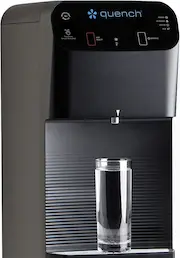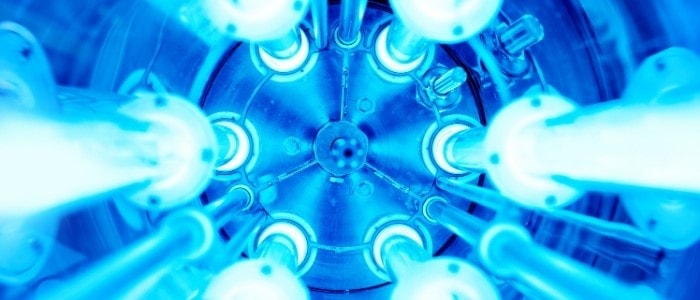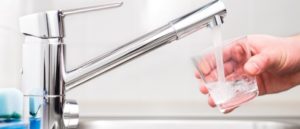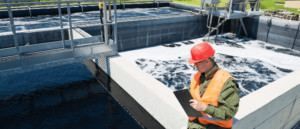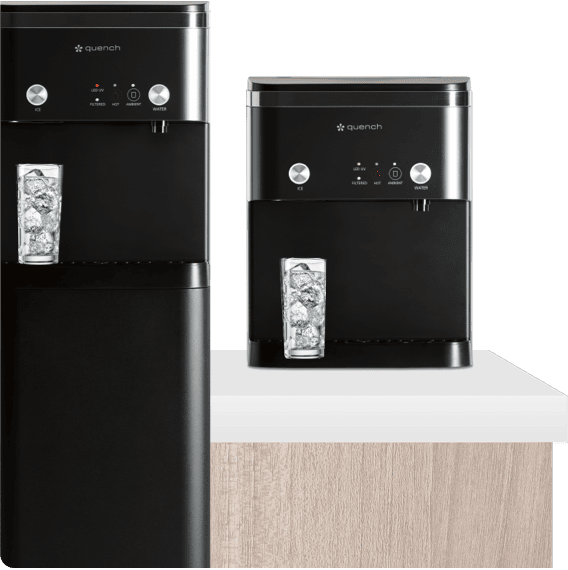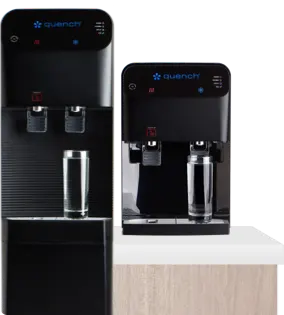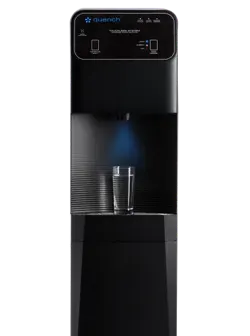UPDATED ON: January 22, 2024
When you think of ultraviolet, what comes to mind? Do you picture black-light posters or recall a painful sunburn? Maybe you think of a scene from a 2006 dystopian science fiction action film. Ultraviolet light is everywhere, and you might have noticed it in unexpected places, like a filtered water dispenser in your daily surroundings.
UV light can destroy 99.99% of harmful microorganisms, making ultraviolet water treatment highly effective in keeping your water clean. Just a simple beam of light not only ensures drinking water is disinfected but also reduces dangerous levels of contaminants.
Read on to discover why Quench Water Experts are passionate about UV water treatment and what this UV disinfection system can do for your daily hydration source.
What Is UV Light?
UV light, also known as ultraviolet light, is a type of electromagnetic radiation with a wavelength shorter than visible light but longer than X-rays. The UV range of electromagnetic radiation extends from 10 nm (nanometers) to 400 nm, and this spectrum is separated into four parts: UVA (315 nm to 400 nm), UVB (280 nm to 315 nm), UVC (200 nm to 280 nm), and UV Vacuum (100 nm to 200 nm).
UVA, UVB, and UVC are the three types of ultraviolet light that lead to UV radiation from the sun, but only UVA and some UVB can get through Earth’s ozone layer. While UVA and UVB rays differ in how they affect the skin, they’re both harmful. Unprotected exposure to UVA and UVB can ultimately damage the DNA in skin cells, producing genetic defects or mutations that lead to skin cancer and premature aging, according to the Centers for Disease Control and Prevention (CDC). Moreover, the Skin Cancer Foundation reports that these UV rays can also cause eye damage, including cataracts, and eyelid cancer.
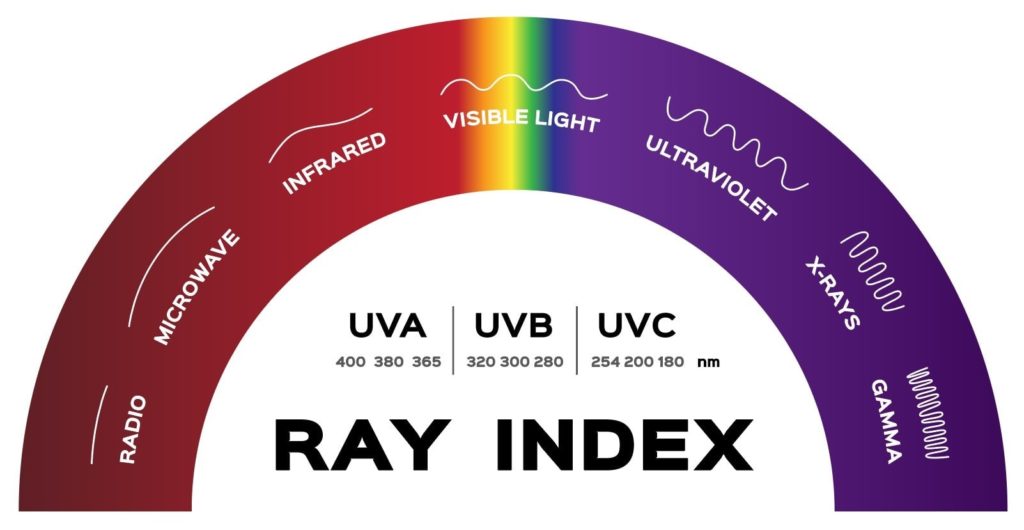
Is It Safe To Drink UVC-Treated Drinking Water?
While we’re taught to protect ourselves from UV radiation throughout our lives by taking cover under big umbrellas or slathering on sunscreen, when it comes to UV water treatment, feel free to leave your sunscreen at home. The type of UV light used to deactivate pathogens in water, UVC (or UV-C), is virtually harmless when exposed to humans for a short period.
Quench filtered water dispensers, for instance, use UVC technology. The absorption length of UVC in humans is so short that almost no radiation can penetrate our living skin cells. Plus, the UV system for water treatment happens within the confines of the filtered water dispensers, which means the risk of exposure to UV light when dealing with the outside of a water tank is extremely low. The Environmental Protection Agency confirms this, reporting that because UV rays don’t add anything to your drinking water during the treatment and disinfection process, it’s safe to drink UV-treated water.
Why Is It Better To Opt for LED UVC Treated Drinking Water?
Opting for LED UVC has quickly become a popular choice for treating drinking water because of cutting-edge technology and the benefits it can provide. Just like LED light bulbs, LED UV lamps outlast traditional UV lamps, resulting in fewer service problems and less waste.
Unlike traditional UV, LED UV doesn’t generate much heat that can be transferred to the water, ensuring your cold water stays cold. Moreover, a traditional UV lamp contains mercury, making them less efficient and emitting harmful UVA and UVB rays that can degrade materials and affect taste. LED UVC light is highly focused with a narrow range of 270 – 280 nm, ideal for ultraviolet disinfection without harming other materials like plastic.
How Does UVC Light Work for Water Disinfection?
To boost your drinking water quality and kill any potential microorganism that could cause you harm, UVC rays can target their cells. This involves going through the outer cell membrane, passing through the cell body, and destroying the nucleic acid — disrupting its DNA and preventing a microorganism from reproducing.
Water Research reveals that in a standard UV system, about 95% of the radiation travels through a quartz sleeve into the untreated water. The water moves in a thin layer over the lamp, and the quartz sleeve is crafted to maintain the lamp at an optimal temperature of around 104°F. How well ultraviolet radiation can neutralize harmful contaminants in your water supply ultimately depends on the strength of the UV light and how long it’s exposed.
What Does UVC Water Treatment Remove?
Quench machines use LED UVC to maintain water’s cleanliness, without adding any chemicals, like chlorine, to the filtered water. Independent testing has concluded that UV disinfection technology can eliminate:
- 99.9999% of bacteria
- 99.999% of viruses
- 99.9% of parasites, including cryptosporidium and giardia
What Is It Best to Use UVC Disinfection?
Because a UV unit is highly effective at minimizing harmful microorganisms in your water supply, UVC water disinfection is ideal for maintaining cleanliness and ensuring safe drinking water year-round. Especially considering that the UVC used in these purifiers is harmless to humans during short exposures.
UV Purifiers vs. Water Filters
Keep in mind that there are key distinctions between UV purifiers and water filters to note. While a water filtration system is designed to remove physical impurities, a UV purifier focuses on neutralizing harmful microorganisms through ultraviolet light. That being said, it’s best to partner UV water treatment with other kinds of water filtration methods. Why? Because UV light water treatment will not have any impact on chlorine, volatile organic compounds, heavy metals, or other chemical contaminants — emphasizing the need for water filtration systems along the way.
Opting for a certified system and combining UV treatment with filtration ensures comprehensive water safety, providing peace of mind for any health-conscious consumer.
In-Tank vs Recirculation
Optimal treatment for your water supplies involves combining UV water sanitization with other filtration systems such as advanced carbon filtration or reverse osmosis. Understanding the two ways UV sanitization operates in filtered water dispensers — in-tank and recirculating — is crucial, as a cutting-edge water filtration system is a key partner to UV sanitization.
In the in-tank method, a UV lamp is placed inside the water storage tank, sanitizing both the tank surfaces and the water drawn from the local water line in a bottleless system. This helps preserve the freshness and taste of filtered water while maintaining the cleanliness of the reservoir.
On the other hand, the recirculating system sanitizes the water itself rather than the tank. A pump within the tank facilitates water flow, and each time water molecules pass the UV lamp, they undergo sanitization. This method is suitable for very large storage tanks, like the Quench Q12. Quench offers bottleless water cooler systems that use both methods, and a certified Quench Water Expert can help you determine which model best fits your needs.
What Are the Advantages of Cleaner Drinking Water?
Whether you’re aware of it or not, your water supply, be it at home or work, has a significant impact on your overall well-being. Introducing a UV water treatment system and advanced filtration technology can bring numerous long-term benefits, including:
- Supporting health and well-being: Failing to implement effective systems to keep your water clean can pose a risk to your health. Clean water is vital for sustaining your well-being and ensuring you feel your best in the long run.
- Driving hydration: Contaminated, unfiltered water inevitably does little for hydration. Drinking water that’s not only clean but tastes great too can quickly boost your daily water intake.
- Promoting greater performance and efficiency: Ultimately, when you feel great, you’re better equipped to improve productivity and efficiency in both your home and work life.
- Preventing potential waterborne illnesses: A water filtration system with a UV sterilizer acts as a proactive measure against waterborne illnesses by helping to minimize harmful microorganisms. This prevents the risk of illnesses related to contaminated water sources.
Quench’s UV Sanitization Keeps Your Office Water Clean
If you’re looking to use UV light disinfection for a cleaner water supply at home or work, Quench has the solution. Quench’s flagship product line, the Quench Q-Series filtered water dispensers, combines UV water treatment with a unique 5-filter system, producing quenchWATER+.
Using advanced filtration technology, Quench units create quenchWATER+ by removing contaminants, pathogens, germs, and unpleasant tastes while adding minerals, electrolytes, and alkalinity for exceptional taste. The integrated LED UV light adds an extra layer of security, ensuring you enjoy the healthiest water possible.
Now that you understand how UV water sanitization works and the associated benefits, it’s clear why Quench Water Experts love talking about ultraviolet technology so much. But the conversation doesn’t have to end here.
Learn more about our UV water treatment, sterilization, and disinfection methods, or get a free estimate to get started.
